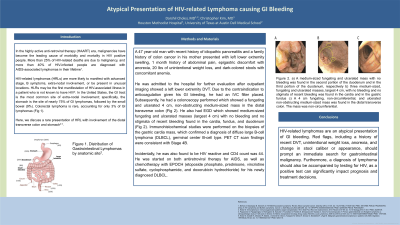Tuesday Poster Session
Category: GI Bleeding
P3506 - Atypical Presentation of HIV-Related Lymphoma Causing GI Bleeding
Tuesday, October 24, 2023
10:30 AM - 4:00 PM PT
Location: Exhibit Hall

Has Audio

Darshil Choksi, MD
University of Texas at Austin Dell Medical School
Austin, TX
Presenting Author(s)
Darshil Choksi, MD1, Christopher Kim, MD2
1University of Texas at Austin Dell Medical School, Austin, TX; 2Houston Methodist Hospital, Houston, TX
Introduction: HIV-related lymphomas (HRLs) are more likely to manifest with advanced stage, B symptoms, extra-nodal involvement, or be present in unusual locations. HLRs may be the first manifestation of HIV-associated illness in a patient who is not known to have HIV. In the United States, the GI tract is the most common site of extra-nodal involvement; specifically, the stomach is the site of nearly 75% of GI lymphomas, followed by the small bowel (9%). Colorectal lymphoma is rare, accounting for only 3% of GI lymphomas. Here, we present a rare presentation of HRL with involvement of the distal transverse colon and stomach.
Case Description/Methods: A 47 year-old man with recent history of idiopathic pancreatitis and a family history of colon cancer in his mother presented with left lower extremity swelling, 1 month history of abdominal pain, epigastric discomfort with anorexia, 20 lbs of unintentional weight loss, and dark-colored stools with concomitant anemia. He was admitted to the hospital for further evaluation after outpatient imaging showed a left lower extremity DVT. Due to the contraindication to anticoagulation given his GI bleeding, he had an IVC filter placed. Subsequently, he had a colonoscopy performed which showed a fungating and ulcerated 4 cm, non-obstructing medium-sized mass in the distal transverse colon (Fig 1). He also had EGD which showed medium-sized fungating and ulcerated masses (largest 4 cm) with no bleeding and no stigmata of recent bleeding found in the cardia and fundus (Fig 1). Immunohistochemical studies were performed on the biopsies of the gastric cardia mass, which confirmed a diagnosis of diffuse large B-cell lymphoma (DLBCL), germinal center B-cell type. PET CT scan findings were consistent with Stage 4B.
Incidentally, he was also found to be HIV reactive and CD4 count was 44. He was started on both antiretroviral therapy for AIDS, as well as chemotherapy with EPOCH (etoposide phosphate, prednisone, vincristine sulfate, cyclophosphamide, and doxorubicin hydrochloride) for his newly diagnosed DLBCL.
Discussion: HIV-related lymphomas are an atypical presentation of GI bleeding. Red flags, including a history of recent DVT, unintentional weight loss, anorexia, and change in stool caliber or appearance, should prompt an immediate search for gastrointestinal malignancy. Furthermore, a diagnosis of lymphoma should also be accompanied by testing for HIV, as a positive test can significantly impact prognosis and treatment decisions.

Disclosures:
Darshil Choksi, MD1, Christopher Kim, MD2. P3506 - Atypical Presentation of HIV-Related Lymphoma Causing GI Bleeding, ACG 2023 Annual Scientific Meeting Abstracts. Vancouver, BC, Canada: American College of Gastroenterology.
1University of Texas at Austin Dell Medical School, Austin, TX; 2Houston Methodist Hospital, Houston, TX
Introduction: HIV-related lymphomas (HRLs) are more likely to manifest with advanced stage, B symptoms, extra-nodal involvement, or be present in unusual locations. HLRs may be the first manifestation of HIV-associated illness in a patient who is not known to have HIV. In the United States, the GI tract is the most common site of extra-nodal involvement; specifically, the stomach is the site of nearly 75% of GI lymphomas, followed by the small bowel (9%). Colorectal lymphoma is rare, accounting for only 3% of GI lymphomas. Here, we present a rare presentation of HRL with involvement of the distal transverse colon and stomach.
Case Description/Methods: A 47 year-old man with recent history of idiopathic pancreatitis and a family history of colon cancer in his mother presented with left lower extremity swelling, 1 month history of abdominal pain, epigastric discomfort with anorexia, 20 lbs of unintentional weight loss, and dark-colored stools with concomitant anemia. He was admitted to the hospital for further evaluation after outpatient imaging showed a left lower extremity DVT. Due to the contraindication to anticoagulation given his GI bleeding, he had an IVC filter placed. Subsequently, he had a colonoscopy performed which showed a fungating and ulcerated 4 cm, non-obstructing medium-sized mass in the distal transverse colon (Fig 1). He also had EGD which showed medium-sized fungating and ulcerated masses (largest 4 cm) with no bleeding and no stigmata of recent bleeding found in the cardia and fundus (Fig 1). Immunohistochemical studies were performed on the biopsies of the gastric cardia mass, which confirmed a diagnosis of diffuse large B-cell lymphoma (DLBCL), germinal center B-cell type. PET CT scan findings were consistent with Stage 4B.
Incidentally, he was also found to be HIV reactive and CD4 count was 44. He was started on both antiretroviral therapy for AIDS, as well as chemotherapy with EPOCH (etoposide phosphate, prednisone, vincristine sulfate, cyclophosphamide, and doxorubicin hydrochloride) for his newly diagnosed DLBCL.
Discussion: HIV-related lymphomas are an atypical presentation of GI bleeding. Red flags, including a history of recent DVT, unintentional weight loss, anorexia, and change in stool caliber or appearance, should prompt an immediate search for gastrointestinal malignancy. Furthermore, a diagnosis of lymphoma should also be accompanied by testing for HIV, as a positive test can significantly impact prognosis and treatment decisions.

Figure: Figure 1. A) A medium-sized fungating and ulcerated mass with no bleeding was found in the second portion of the duodenum and in the third portion of the duodenum, respectively. B) Three medium-sized, fungating and ulcerated mass, largest 4 cm, with no bleeding and no stigmata of recent bleeding was found in the cardia and in the gastric fundus. C) A 4 cm fungating, non-circumferential, and ulcerated non-obstructing medium-sized mass was found in the distal transverse colon. The mass was non-circumferential.
Disclosures:
Darshil Choksi indicated no relevant financial relationships.
Christopher Kim indicated no relevant financial relationships.
Darshil Choksi, MD1, Christopher Kim, MD2. P3506 - Atypical Presentation of HIV-Related Lymphoma Causing GI Bleeding, ACG 2023 Annual Scientific Meeting Abstracts. Vancouver, BC, Canada: American College of Gastroenterology.
